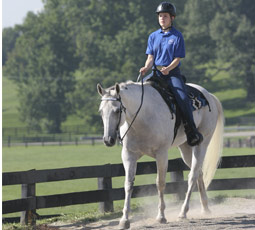 |
Great equitation is not just about looks; it’s about being a proficient rider. If you’re the type who is passionate about getting the most out of your horse’s performance, learning to ride in balance with him will produce impressive results.
Your position in the saddle has a remarkable influence on your horse’s performance. A balanced rider provides the support a horse needs to travel in a balanced frame, maintain quality gaits, make smooth transitions and maneuver with greater ease. The eternal principle of proper equitation will never change. Ride with your body in vertical alignment: ears over shoulders, shoulders over hips and hips over heels (with your heels dropped slightly lower than your toes). It’s this alignment that suspends you over the center of the horse’s motion.
It’s remarkable how a creature as massive as a horse can be thrown off kilter, unable to pick up the correct lead or incapable of maintaining a steady pace when a relatively small-sized rider on his back leans this way or that. A horse will react to subtle shifts in the rider’s weight and will compensate by doing what is easiest for him, even if that isn’t what the rider wants.
Pivotal Points
It takes time, practice and more practice to stay in balance with a moving horse. Imagine that your horse is actually a four-way teeter-totter. As his head and neck lift, his hind end drops down, and vice versa. From left to right, your horse can shift weight from one side to the other. Sitting over the pivot point behind his withers, leaning neither forward, nor back, nor left or right, will keep the teeter-totter—your horse—traveling in a level and balanced frame.
To find that axis point in the center of your horse’s motion, ask him to track a straight line at the walk. If you feel comfortable, close your eyes during this exercise to help you tune in to your body. Otherwise, keep your eyes focused ahead on the horizon. Breathe deep into your belly, then let the air out slowly. Allow your body to relax.
Now, imagine a neon pink stripe running along the length of your horse’s topline from poll to dock. See yourself sitting in the middle of that line with your weight evenly distributed over your right and left seat bones, down each leg and into each stirrup. Next, imagine a bright yellow stripe that bisects the center of your saddle from left to right. Prevent yourself from being pulled ahead of or behind that yellow line by lifting your rib cage and stabilizing your core muscles (abdominal and lower back). As you engage your stomach muscles, allow your lower back and hips to remain soft and follow your horse’s motion. When you’re feeling success at the walk, use this balancing imagery to help you stay centered at the jog and lope, as well.
Seat Bones and Balance
As you learn to actively maintain your balance, you’ll begin to develop a more solid and useful connection between your seat bones and the saddle. To find your seat bones, take your feet out of the stirrups and lift your legs up to the pommel with your knees bent; this position puts you in contact with the saddle via your seat bones. You can do this at either a halt or a walk. Move your legs back into position slowly so that you don’t startle your horse. Then, train yourself to feel when you’ve lost seat bone contact, and how to get it back, by experiencing the extremes of bad balance through the following exercises.
While at a halt or at the walk, sit up tall. Take you feet out of the stirrups. With your heels pushed down, extend your legs as far forward toward your horse’s shoulders as you can. Hold the position for as long as possible, and then rest. Next, bring your legs as far back behind you as possible (avoid hitting your horse in the flanks). Point your toes downward for an added stretch. Alternating between having your legs too far ahead and too far behind may feel awkward, but it will help you find your balance. As an added benefit, these stretches strengthen your stomach muscles and create a stronger and longer leg.
Riding correctly with a long leg and minimal bend at the knee will allow you to carry the maximum amount of weight in your stirrups. That means your horse will have less weight on his spine. You’ll also have a lower center of gravity, which will add to your stability in the saddle, allowing your horse to move more freely and helping you keep up with him during quick stops and turns.
Standing in the saddle and posting the trot are great ways to build your muscle strength and endurance. These exercises also improve your leg position and help you transfer more weight into your stirrups. Start by standing at the walk or extended jog. Bring your legs as far back as you can, and push your hips forward and out of the saddle. Try to keep your heels slightly below or at least level with your toes. Hold this position until you can’t stand any longer, and slowly lower yourself into the middle of the saddle with your pelvis tilted forward so that you sit on your seat bones.
To post the extended jog or the trot—gaits that need more active riding—push your hips up and slightly forward out of the saddle by pressing the balls of your feet into your stirrups. Allow your knees to straighten and your heels to stretch down as you rise up. Pull your shoulders back and lift your chest.
Support Your Horse
A balanced horse works off his hind end, lifting his shoulders and elevating his back to allow his hind legs to reach further under his body. Strength and stamina will make it easier for you to actively support your horse’s balance while he’s in motion.
To help your horse maintain a relaxed and balanced stride at the walk, sit upright in the saddle, lengthen your legs, and soften your hips. At the jog, some horses tend to shift their weight side-to-side, which indicates a lack of impulsion from the hindquarters. To discourage your horse from performing a sloppy jog, elevate your rib cage and tighten your stomach muscles. Press weight evenly into both stirrups, and use your seat muscles to steady your hips in the saddle. As your body stabilizes, you’ll counteract the side-to-side movement, and your horse’s jog will improve.
Riding the Lope
The lope is an inherently uneven gait and the most difficult to ride correctly. To help your horse maintain balance and consistency at the lope, focus on staying centered in the saddle. Horses often carry too much weight over their forehand and end up dropping weight over their inside shoulder. If you’re not supporting yourself, you could be pulled out of position. You’ll have to work at preserving your balance. Keep your weight evenly distributed in both stirrups. Maintain the “heels under your hips and lower than your toes” position. Also, sit with slightly more weight over your outside seat bone to lighten the load on your horse’s inside shoulder. Shifting your weight slightly rearward by pressing your seat bones into the saddle and tilting your pelvis slightly forward will also encourage your horse to drive from his hind end.
Balanced Transitions
Using an active seat will improve transitions, as well. For upward transitions, lift your rib cage to lighten the weight on your horse’s back. That will make it easier for him to round his topline and set him up for a smoother change of gaits. Also, relax your hips and press down and forward into the saddle with your seat bones. Your seat bones will activate your horse’s hind end and signal him to drive forward with his hocks. The more energetically you push, the more powerfully he will respond.
Before giving your horse a verbal or rein cue for a downward transition, prepare him by pressing down into your heels, relaxing and rounding your lower back by tilting your pelvis forward for a deeper seat. There are two common mistakes to avoid during downward transitions and stops: leaning backward and bracing your back or legs. Therefore, remember to stay upright and relaxed in your lower back. Engage your stomach muscles to maintain your stability so that you don’t interfere with your horse as he adjusts his balance moving through the downward transition or coming to a stop.
Balanced Circles
Circles require the horse to carry himself in a curved frame that corresponds with the arc of the path he’s traveling on. This is not a concept that horses inherently understand. However, your proper position in the saddle will enhance your horse’s correct bend on the circle. To encourage your horse to bend, slide your inside leg a couple of inches forward and your outside leg a couple of inches back. Your inside leg will support your horse’s shoulder and discourage him from leaning or drifting to the inside of the track. Your outside leg will help keep his hips from swinging out. Because the bend pushes your horse’s rib cage onto the outside edge of the circle, shift your weight subtly in that direction so that you’re still centered over your horse and supporting his position.
Don’t let your upper body twist into the direction of the turn. There is a natural tendency to lean and/or turn ahead of the horse. Pulling your inside elbow behind your hip to guide your horse into the circle will cause your body to twist even more. It will also overbend your horse in the neck and pull him onto his inside shoulder, eventually causing him to fall off the track of the circle. Hold your inside elbow in front of your inside hip while keeping your outside elbow in line with your outside hip—this helps put you square in the saddle and prevents dragging your horse around the circle with the inside rein. Think inside hand forward, outside hand back whenever you are riding a circle or any change of direction. To maintain contact while keeping your inside hand slightly ahead of the outside hand, you’ll need to adjust the length of the rein. If you have trouble staying square on your horse while he’s bending, over exaggerate the correct position. As it becomes more natural, you can hold your hands more evenly.
Horseback riding is an interactive sport, not a spectator event. What you’re doing in the saddle has a direct influence on your horse’s gaits, his balance and his ability to perform. By becoming a balanced rider, you provide support to the horse beneath you, creating a cooperative partnership to achieve results.
Dale Rudin teaches her “Performance Through Partnership” techniques near her home in Tennessee and offers clinics nationwide. She also authors “Western Lessons” in Young Rider Magazine. www.dalerudin.com.

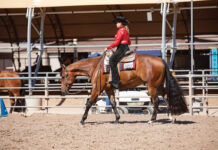
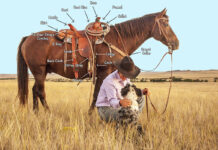
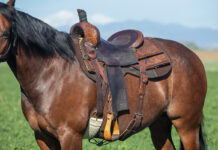
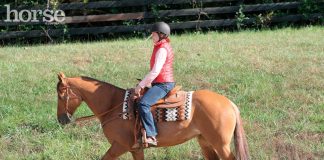

Beautifully written. This is very clear, explicit. It’s easy to visualize and understand.
Wonderfully clear article that reinforces the basics of dressage, as I’ve been learning them these past 7 months.